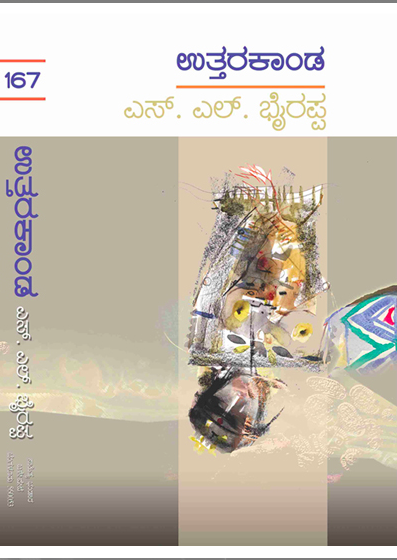ಪಾತ್ರ ಪರಿಶುದ್ಧತೆ ಅನ್ನುವುದು ಹಲವಾರು ಲೇಖಕರಿಗೆ ಕೈಗೆಟುಕದ್ದು; ಪಾತ್ರವೊಂದನ್ನು ಸೃಷ್ಟಿಸಿದರಷ್ಟೇ ಸಾಲದು; ಅವಕ್ಕೆ ತಮ್ಮದೇ ವ್ಯಕ್ತಿತ್ವವನ್ನೂ ಪೊರೆಯಬೇಕಾಗುತ್ತದೆ; ಪ್ರತಿಯೊಂದು ಪಾತ್ರವೂ ತನ್ನ ಗ್ರಹಿಕೆ ಹಾಗು ಪ್ರತಿಕ್ರಿಯೆಯನ್ನೂ ತಂತಮ್ಮ ಭಾವದ ನಿಲುಕಿನ ಸೂಕ್ಷ್ಮತೆಗನುಗುಣವಾಗಿ ಕಟ್ಟಿಕೊಡಬೇಕಾಗುತ್ತದೆ. ಲೇಖಕರೊಬ್ಬರು ಹಲವಾರು ಪಾತ್ರಗಳಲ್ಲಿ ತಮ್ಮನ್ನು ತೊಡಗಿಸಿಕೊಂಡು ಕಥೆ ಸಂದರ್ಭಗಳನ್ನು ಹೆಣೆಯಬೇಕಾಗುತ್ತದೆ. ಪಾತ್ರದ ಹರವು ಲೇಖಕನ ಯೋಚನೆಗೆ ಮಿಳಿತವಾಗುತ್ತ ಎಲ್ಲಿ ಹೋಗುತ್ತದೋ ಅಲ್ಲಿ ವಸ್ತುನಿಷ್ಠತೆಯಿಂದ ಕಥೆಯ ಪಾತ್ರ ದೂರ ಸರಿಯುತ್ತ ಹೋಗುತ್ತದೆ. ಅಲ್ಲಿ ಓದುಗನ ಮನಸ್ಸಿನಲ್ಲಿ ಏಕತಾನತೆ ಅಥವಾ ಗೊಂದಲ ಮೂಡುವ ಸಾಧ್ಯತೆಯಿರುತ್ತದೆ.

ಭೈರಪ್ಪನವರು ತಮ್ಮ ಪ್ರತಿಯೊಂದು ಕಾದಂಬರಿಯಲ್ಲಿಯೂ ಈ ವಸ್ತುನಿಷ್ಠತೆಯನ್ನು ಕಾಪಾಡಿಕೊಂಡಿರುವುದರಿಂದಲೇ ಅವರ ಪುಸ್ತಕಗಳನ್ನು "ism" ಗಳಿಗಾಗಲೀ, ನಿರ್ದಿಷ್ಟ ವರ್ಗಕ್ಕಾಗಲೀ ಸೇರಿಸಲು ಬಂದಿಲ್ಲವೇನೋ. ಪ್ರತಿಯೊಂದು ಪುಸ್ತಕದಲ್ಲಿಯೂ ಪಾತ್ರಗಳು ಯೋಚಿಸುವ, ಪ್ರತಿಕ್ರಿಯಿಸುವ ರೀತಿಯೇ ವಿಭಿನ್ನ. ಉತ್ತರಕಾಂಡ ಈ ಹಿನ್ನೆಲೆಯಲ್ಲಿ ಅವರ ಹಿಂದಿನ ಎಲ್ಲ ಕಾದಂಬರಿಗಳಿಗಿಂತ ಭಿನ್ನ. ಪರ್ವದಲ್ಲಿನ ದ್ರೌಪದಿಗೂ ರಾಮಾಯಣದಲ್ಲಿನ ಸೀತೆಗೂ ಅಜಗಜಾಂತರ. ಅಲ್ಲಿನ ಮಹಾಭಾರತ ಯುದ್ಧದ ವಸ್ತುನಿಷ್ಠ ವಿಡಂಬನೆಗೂ, ಇಲ್ಲಿನ ಯುದ್ಧದ ಮೇಲು-ಮೇಲಿನ ವರ್ಣನೆಗೂ ಅಜಗಜಾಂತರ. ವಸ್ತು ಅಲ್ಲಿ ಸಂದರ್ಭಗಳಾಗಿದ್ದರೆ, ಇಲ್ಲಿ ಮುಕ್ಕಾಲು ಪಾಲು ಸೀತೆಯ ಸ್ವಗತದಲ್ಲಿರುವುದರಿಂದ ನಿರೂಪಣೆ ಹಾಗು ಅದರ ಒತ್ತು ಭಿನ್ನ.
ಒಂದೊಂದು ಪಾತ್ರಗಳಿಗೂ ಕಟ್ಟಿಕೊಟ್ಟಿರುವ ವ್ಯಕ್ತಿತ್ವ ಮೂಲ ರಾಮಾಯಣಕ್ಕೆ ಧಕ್ಕೆಯಾಗದಂತೆಯೂ ಇದ್ದು ನೈಜ ಚೌಕಟ್ಟನ್ನು ಧರಿಸಿ ಕೊಟ್ಟಿರುವ 'ಉತ್ತರಕಾಂಡ" ಮತ್ತೆ ಮತ್ತೆ ಓದಿಸಿಕೊಳ್ಳುವುದು ನಿಶ್ಚಯ.
ಯಾವುದೊ ಸಂದರ್ಭದಲ್ಲಿ ಬದುಕಿನಿಂದಲೋ, ಪ್ರೀತಿಸುವವರಿಂದಲೋ ಅಕಾರಣ ತಿರಸ್ಕೃತರಾದಾಗ ನಡೆಯಬಹುದಾದ ಮನ ಮಂಥನ ನಾವು ಸಮಾನ ರೂಪದ ಸಂದರ್ಭಗಳನ್ನು ಎದುರಿಸುವಾಗ ಖಂಡಿತಾ ಉಪಯೋಗಕ್ಕೆ ಬಂದೀತು. ಲಕ್ಷಣನ ವ್ಯಕ್ತಿತ್ವವನ್ನು ಇಡಿಯಾಗಿ, ಘನವಾಗಿ ಕಟ್ಟಿಕೊಟ್ಟಿದ್ದಾರೆ. ಅತ್ತಿಗೆ ಮೈದುನರ ಸಂಬಂಧವನ್ನು, ಅವರ ನಡುವಿನ ಮುನಿಸಿನಲ್ಲಿ ಸಹ ತೋರಿಸಿಕೊಟ್ಟಿದ್ದಾರೆ. ಇದು ಸೀತೆಯ ರಾಮಾಯಣವಾದರೂ ರಾಮ ಇಲ್ಲಿ ಸ್ತ್ರೀ ಪೀಡಕನಲ್ಲ ; ಧರ್ಮಪಾಲನೆಯಲ್ಲಿ ಲೋಲುಪತೆ ತೋರಿಸಲಾರದ ಪರಿಸ್ಥಿತಿಗೆ ಕಟ್ಟುಬಿದ್ದು ಅತ್ಯಂತ ಪ್ರೀತಿಪಾತ್ರರಿಗೆ ಹಿಂಸೆಯಾಗುವಾಗ ತನಗರಿವಿದ್ದೂ ನಿಸ್ಸಹಾಯಕನಾಗಿಬಿಡುವಾಗಿನ ಆರ್ದ್ರತೆ ಮನಮುಟ್ಟುವಂತೆ ಚಿತ್ರಿಸಿದ್ದಾರೆ. ರಾಮ ಸೀತೆಯರ ಅಗಲಿಕೆಯ ನೋವು, ನಂತರದ ಉತ್ತರಕಾಂಡದಲ್ಲಿ ಇಡೀ ರಾಮಾಯಣವನ್ನೇ ದೈವಿಕತೆಯ ವಿಜೃಂಭಣೆಯಿಲ್ಲದೆ ನಡೆದಿದ್ದರೆ ಹೀಗೆಯೇ ನಡೆದಿರಬೇಕೆನ್ನುವಂತೆ ಕಲ್ಪನೆಗೆ ಕಟ್ಟಿಕೊಟ್ಟಿದ್ದಾರೆ ಭೈರಪ್ಪನವರು.
ಮಹಾಭಾರತದ ಮುಂದೆ ರಾಮಾಯಣ ಚಿಕ್ಕದು. ಸಂದರ್ಭಗಳಲ್ಲಿ, ಒಳ ಕಥೆಗಳಲ್ಲಿ, ಹರವಿನಲ್ಲಿ. ೪ ಸಾಲುಗಳಲ್ಲಿಯೂ ಹೇಳಬಹುದಾದ ಕಥೆ - ರಾಮಾಯಣ. ಈಗ ಅದನ್ನೂ ಚಿಂತನೆಗೆ ಹಚ್ಚಿ ಮನಸ್ಸಿನ ತೊಳಲಾಟಗಳಿಗೆ, ಭಾವ ವಿಮರ್ಶೆಗೆ ಪಕ್ಕಾಗಿ ಅಣಿಗೊಂಡಿದೆ - ಉತ್ತರಕಾಂಡದಲ್ಲಿ. ಓದಿದ ನಂತರ ತಕ್ಷಣ ಉಳಿಯುವ ಭಾವ ಮಾತ್ರ ವಾಲ್ಮೀಕಿ ಮಹರ್ಷಿಯದ್ದೇ- "ಪಕ್ಷಿಗಳ ಅಗಲಿಕೆಗೆ ಮರುಗಿ ಮಹಾಕಾವ್ಯ ರಚಿಸ ಹೊರಟರೆ ಕಾವ್ಯದಲ್ಲೂ ರಾಮ ಸೀತೆಯರನ್ನು ಒಂದುಗೂಡಿಸಲಾಗಲಿಲ್ಲವೆಂಬ ಸ್ಥಾಯೀಭಾವ, ನಿಟ್ಟುಸಿರು, ಕಣ್ಣಂಚಲ್ಲೆರಡು ಕಂಬನಿ ಬಿಂದು.
